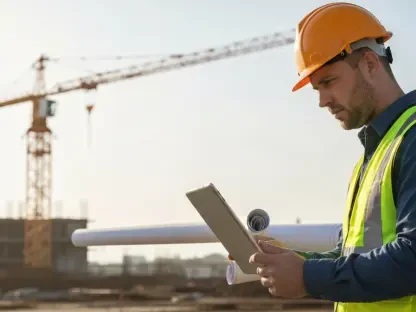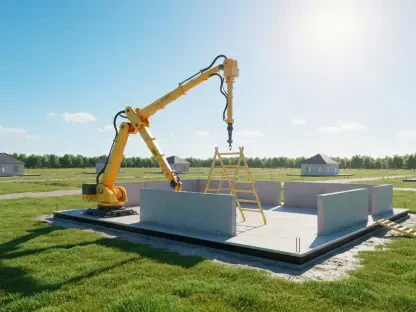I’m thrilled to sit down with Luca Calarailli, a seasoned expert in construction with a deep background in design and architecture. Luca’s passion for integrating technology into the industry makes him the perfect person to discuss the latest trends and innovations, especially in light of the recent NFPA survey on AI adoption and skilled trades. Today, we’ll dive into the evolving role of digital tools, the impact of AI on labor shortages and workforce appeal, the importance of training and certifications, and the value of professional memberships in shaping the future of skilled trades.
How did you first become interested in the intersection of technology and the skilled trades, and what excites you most about the findings from the latest NFPA survey?
I’ve always been fascinated by how technology can solve real-world problems, especially in construction where efficiency and precision are everything. Early in my career, I saw how digital tools could streamline design processes, and that sparked my interest in broader applications. The latest NFPA survey is exciting because it shows a huge shift—95% of respondents see AI as relevant to their daily tasks. That kind of acceptance signals a turning point for the industry, and I’m thrilled to see how it’s opening doors to innovation while tackling challenges like labor shortages.
Can you walk us through the key focus of the third annual NFPA survey and what it reveals about the current state of the skilled trades?
The third annual NFPA survey, conducted at the 2025 Conference & Expo, really zeroes in on how skilled trades professionals perceive industry shifts, especially with technology and workforce dynamics. It captures opinions on AI, digital tools, training, and certifications amidst ongoing labor shortages and infrastructure demands. What stands out is the optimism around tech—most see it as a game-changer for productivity and attracting new talent, though there’s still some skepticism. It paints a picture of an industry at a crossroads, balancing tradition with a tech-driven future.
With 95% of respondents believing AI has a place in daily tasks, can you share some specific ways AI is being used in the skilled trades right now?
Absolutely. AI is popping up in areas like project planning and safety management. For instance, it’s being used to analyze blueprints and predict potential design flaws before construction even starts. On job sites, AI-powered tools help with equipment maintenance by flagging issues before they become major problems. It’s also aiding in risk assessment—think algorithms that predict fire hazards based on building layouts. These applications aren’t just cool; they’re saving time and reducing errors in a field where precision is critical.
The survey mentions that about a third of respondents see AI as a solution to labor shortages. How exactly is AI helping to bridge that gap?
Labor shortages have been a persistent headache in the trades, and AI is stepping in by automating repetitive or time-intensive tasks. For example, AI can handle inventory management or scheduling, freeing up workers to focus on hands-on skills. It’s also being used in training simulations, allowing new hires to learn faster without needing constant supervision. By taking on these background tasks, AI lets smaller teams do more, which is a lifeline when you’re struggling to find enough skilled hands.
Nearly 40% of respondents are hopeful that AI could draw in younger, tech-savvy workers. What do you think makes AI so appealing to the next generation in this industry?
Younger workers grew up with technology, so they’re drawn to fields where digital tools are front and center. AI represents a modern, cutting-edge approach to trades that might otherwise seem old-school. Imagine a job site where you’re using apps to troubleshoot issues in real-time or wearing smart gear that monitors safety conditions—that’s exciting to a tech-native generation. Plus, AI can make the work feel less physically grueling by automating heavy lifting tasks, which could shift perceptions of the trades as a career path.
On the other hand, 25% of respondents remain skeptical about AI. What are some of the concerns or hesitations you’ve noticed around adopting this technology?
Skepticism often comes from a fear of the unknown. Some workers worry that AI might replace jobs rather than complement them, especially for roles that seem automatable. There’s also concern about reliability—can you trust a machine to make decisions in high-stakes situations like fire safety? And let’s not forget the learning curve; not everyone feels comfortable with tech, especially if they’ve relied on traditional methods for decades. These are valid concerns that need addressing through education and gradual integration.
The survey noted a 64% improvement in teamwork and workflows thanks to digital tools. Can you give an example of how these tools are transforming day-to-day operations on job sites?
Digital tools are revolutionizing collaboration. Take something like cloud-based project management platforms—everyone from architects to on-site crews can access real-time updates on plans, schedules, and issues. I’ve seen teams use these tools to instantly share photos of a problem area, get feedback, and resolve it without waiting for a meeting. It cuts down on miscommunication and keeps projects moving smoothly. That kind of efficiency builds trust and teamwork, which is huge in an industry where delays can be costly.
Training remains a priority, with 78% of skilled workers engaging in NFPA programs. What types of training do you see as most sought-after in the field today?
Safety training is always at the top of the list, especially programs focused on fire prevention and emergency response—core areas for NFPA. There’s also a big demand for technical skills related to new systems, like smart building technologies or energy-efficient designs. Workers want to stay current, so courses on codes and standards updates are popular too. These programs aren’t just about checking a box; they’re about building confidence and competence in a rapidly changing field.
Despite the interest in training, barriers like time and cost persist. How are workers and organizations finding ways to overcome these hurdles?
Organizations are getting creative. Some are offering in-house training sessions during work hours to tackle the time issue, while others partner with associations like NFPA for discounted programs to cut costs. Online modules are a game-changer too—they let workers learn at their own pace without needing to travel. I’ve also seen companies prioritize group training to build team skills while keeping expenses down. It’s about making learning accessible without sacrificing job site productivity.
What’s your forecast for the future of AI and digital tools in the skilled trades over the next decade?
I think we’re just scratching the surface. Over the next ten years, AI and digital tools will become even more integrated into every aspect of the trades—from design to maintenance. We’ll likely see smarter job sites with wearable tech and IoT devices tracking everything from worker safety to material usage. AI could also play a bigger role in predictive analytics, helping prevent issues before they arise. The challenge will be ensuring everyone gets on board through training and support, but I’m optimistic that these tools will make the trades safer, more efficient, and more attractive to new talent.









